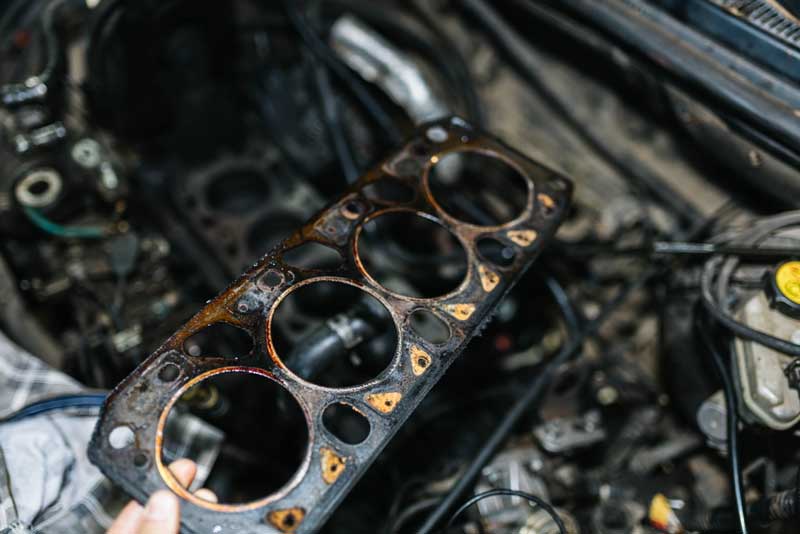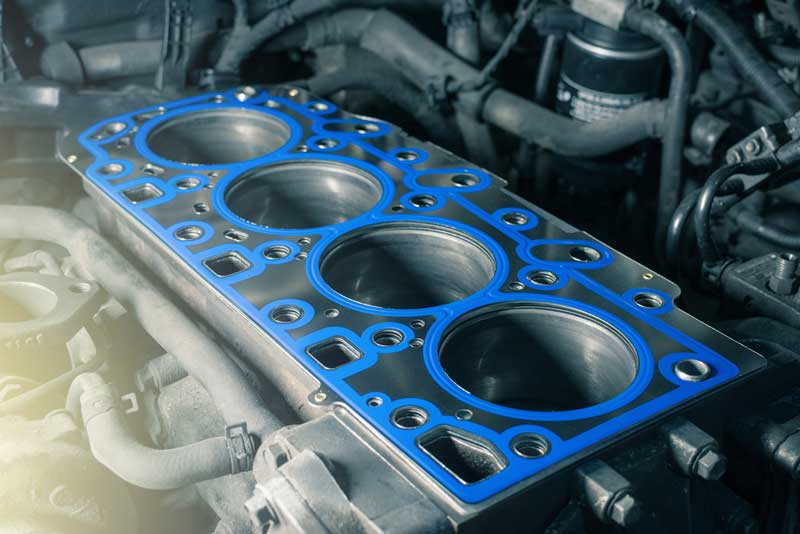Did you observe some smell or sound from your engine? Do you feel there is a leakage from your head gasket? What really makes the head gasket leak?
If any of these are your thoughts, we have got you covered in this article with all you need to know about head gasket leaks.
It’s important to know that an overheating engine is one of the major cause of a head gasket leak.
In the course of the article, we will examine the causes of head gasket leakage, signs of a blown head gasket, how to avoid faulty head gaskets, the cost of repairing a blown head gasket, and lots more.
So relax, let’s ride!
Why Does My Head Gasket Leak
A leaking head gasket shows the following common signs among others: Low coolant level in your reservoir. Coolant puddles under your vehicle. A strong, pungent smell when your engine is hot – some people term it a “sweet” smell coming in through the car vents.
As time passes, the internal combustion engine becomes open to possible failures. Some of the failures are few in scope, whereas the rest can result in crucial drivability problems, which amount to an expensive repair.
A blown head gasket is on top of the list of discomforting problems faced by motorists, whose engines have started aging. Fortunately, the repairs to the head gasket are cheap and easy to do.
When you quickly identify the signs, you can easily start the repairs. Thus, you can continue driving as soon as it is done.
Continue reading to get more information about the function of the engine’s head gasket, and other symptoms that come with a blown head gasket.

Reasons Why a Head Gasket Could Leak?
The head gasket can become faulty, because of so many reasons. However, it is important to note that overheating is the most prevalent cause. Overheating the engine is usually caused by the coolant leak, which leads to an unexpected onset of head gasket problems.
Overheating damages the head gasket, because of the unexpected metal expansion along critical surfaces of an engine. The more serious the overheating gets, the increased chance of head gasket damage.
A notable increase of the engine’s block deck or cylinder heads leads to a division between the two surfaces, which can compromise the seal of a head gasket. Even when a single overheating episode fails to result in sudden head gasket damage, the lifespan of the seal weakens.
Sudden ignition or detonation of air/fuel outside your flame front, may result in subsequent head gasket failure. It stems from detonation, leading to failure of firing rings of the head gasket, which gives room for compression seepage.
Also Read: Oil Pan Replacement Cost
Signs of a Blown Head Gasket
Head gaskets that are blown can show many signs, which can help you diagnose. However, the appearance of these signs varies depending on the car, and it also depends on the specific portion of your head gasket that was affected.
Below are common signs of a faulty head gasket:
Overheating of Engine
Faulty head gaskets may have resulted from engine overheating, most of the time. For example, overheating resulting from a faulty fan, coolant leak, clogged radiator, etc. Note that when the head gasket is blown, your engine can overheat. Hot exhaust gases can leak, and go inside your coolant or cooling system and into your cylinders, then burn off as steam; in any way it happens, it will result in the engine overheating.
Suppose you drive your car when it is overheating, it can lead to the steam or alloy cylinder head wrapping, damaging your catalytic converter, and significantly adding to the expenses on repair.
Power Loss
When the head gasket fails, it lets the compressed fuel/air go out(escape), reducing the cylinder compression. This leads to an engine power reduction and an unsteady running engine. Also, this kind of failure comes with a sound like an exhaust leak.
Oil Becomes Contaminated
Among the head gasket failure signs, the most notable is a milky sludge on your oil filter’s underside or your car’s dipstick; some people jokingly call it “milkshake”. It results from coolant going into your oil, or the other way round. Though it is not a conclusive sign of a faulty head gasket, it is a sign that you need to disassemble your engine and find the cause of the contamination.
When antifreeze contaminates the oil, your engine bearing will be ruined if you drive with such a car. A good repair requires the engine oil to be flushed, and the oil filter replaced. Most times, you are also recommended to completely disassemble the bottom of your engine, to ensure your bearings are not damaged and to get rid of contaminated oil.
White Smoke From Exhaust
A head gasket with a fault often results in a large quantity of white smoke that has a sweet smell from your exhaust. Antifreeze leaking into your cylinders past your gasket, where it turns into steam as a component of its combustion process, is what causes it. The least common is a leak from the oil passage to your cylinder, leading to bluish smoke.
Any gasket failure will allow combustion pressure into the oil breather or cooling system. If the radiator hose unexpectedly blows off the water outlet, or your dipstick fails to stay put, this may be the reason.
External Leakages
When the head gasket fails between the oil or water passage and the outer part of an engine, it can result in an oil leak or coolant. This is a less serious version of a blown head gasket, but it is still crucial.
It may not be a sudden issue (aside from making a mess), but when your coolant level is given room to drop, it can cause extreme engine problems. Another problem is that oil leaks can get to the hot exhaust and possibly cause fire and acrid smoke.
Continual Loss of Coolant
When coolant seems to consistently reduce in your vehicle, without any noticeable leaks, it is possible that you are to blame your engine head gasket.
As a result of the inner nature of the head gasket leak, without being visibly expelled, coolant is burnt.
The Cooling System has bubbles
When there are ill-directed combustion gases, you notice a steady but slow coolant bubbling within the surge or radiator tank. There is a specialized combustion gas detector, which is used to confirm the condition without stress.
Coolant Becomes Milky
The leakage of one’s head gasket normally leads to the combination of coolant and oil. When it happens, the coolant takes on brown or grey coloring and comes in a milky form.
Also Read: Head Gasket Repair Cost
Checking Head Gasket Failures
You would be on the safe side spending the little dollars now, rather than spending hundreds afterward for repairing a blown head gasket. Although it is not expensive to replace the gasket, the entire process of reassembly and dismantling, is intensive for the laborer hence, the increase in the amount paid for repairs, especially on luxurious and modern vehicles.
The head gasket normally fails, when you keep driving an overheated vehicle or consistent overheating. Hence, the prevention method ensures that the cooling system will always be in stable, and good condition. When the car begins to over boil, park it and allow it to cool for about one hour, then refill its radiator and continue.
It is simple to check your cooling system. You do so by checking all the joints and pipes for leaks (there’s always dampness if a leak exists), ensuring that your radiator is working efficiently, your thermostat opens appropriately, and your coolant is up to its proper level. In addition, check if your fan is functioning, all the blades are intact, and have the shroud to increase how it functions.
If you feel your head gasket is failing, you can perform a scientific test, by checking the combustion gases in your cooling system. So, if it is a blown head gasket, remove your radiator cap (if its cooling system is cold), turn on the vehicle, and in your coolant, check for bubbles.
You should know that the above will not be seen if there are other failure spots with your head gasket.
Older gaskets fail because they are not robust enough, their design is poor, or both. This issue is frequently applied to older metal gaskets, which will only last for some years of interchanging hot and cold before it fails. Luckily, multiple modern layer steel (MLS) replacement gaskets, are recently available for many applications, and improved reliability.

Can One Drive with a Blown Head Gasket?
Usually, cars can be driven when their head gasket is blown, but you are advised not to. This is because, the seal between a cylinder head(s) and the engine’s block, is crucial to an engine’s performance. The degradation of the seal ultimately leads to numerous drivability problems.
A head gasket that is leaking often leads to extra overheating problems. Most leaking head gaskets allow coolant loss by escaping into a particular cylinder, or external leakage.
In a matter of time, coolant loss vigorously reduces the ability of the cooling system to control engine temperatures.
In most cases, a leaking head gasket allows the lube oil of an engine to mix with coolant. When it happens, you cannot avoid oil dilution. In addition, the oil viscosity loss easily causes havoc on the engine’s severe bearings.
The result is that a leaking head gasket subsequently gives room for a total engine overhaul.
Cost of Blown Head Gasket Repair
Replacing the head gasket is expensive. However, the specific cost for such repairs varies based on the model of the car.
This price difference can be linked to the cost difference between specific gaskets, and the amount that will be spent on labor needed to change the head gasket(s) on a particular engine.
The estimated price ranges from $1,200 to $2,000, to replace a total head gasket. The less amount reflects on replacing the inline-style engine. In contrast, the higher price spectrum relates to the high-end “V” engine configuration.
How to Fix a Blown Head Gasket Without Replacing It
Making use of K-Seal Ultimate, K-seal, or K-Seal HD will permanently fix and repair failing head gaskets; it includes:
- The coolant for the oil leaks
- The cylinder to the coolants leaks
- Head gasket that is blown
- The coolant to the cylinder leaks
Could This Affect Other Parts of My Engine?
It is known that the head gasket is usually the cause of engine malfunction, but it is not the only component you should examine. Pick an engine component in this engaging diagram below, to explore the engine and its important components.
Why You Shouldn’t Disregard Symptoms of Blown Head Gasket
Most drivers tend to ignore persistent problems because they do not want to consider the amount that may be spent on possible repairs. Thus, when you leave the problem for a long time, be ready for major damage.
For instance, changes in the coolant leaks and coolant temperature can:
- Because coolant leaks into your engine oil, ruining your engine.
- From a mixture of combustion gases and coolant, the engine overheats.
- Your catalytic converter is damaged
- The engine lubrication is eroded.
In the end, you will spend way more than what you would have, if you fixed the issue as soon as you noticed it, mostly because when an engine is overheating, more problems can arise. Such as:
- Hoses erosion
- Radiator fails
- Damage to your cooling system.
Also Read: Head Gasket Replacement Cost
Frequently Asked Questions – Head Gasket Leak
Can you still drive with a leaking head gasket? Or a Blown head gasket?
It is risky to do so because it will amount to further vehicle issues. A K-Seal stops such issues before it becomes too late. One can drive when the head gasket is blown, but you are advised not to.
How serious is a head gasket leak?
Very serious. If the leak becomes too much, your engine will lose compression. It can make your engine run rough when idle, stalling, and even knocking. It is important that numerous issues can also cause this.
How much does it cost to fix a head gasket leak?
The amount spent on repairing your head gasket can be above a thousand dollars; thus, it is less expensive to scrap your car than to repair it. To repair the head gasket, you will spend between $1,000 – $2,000 because parts are costly.
Can you fix a leaking head gasket without replacing it?
Most blown head gaskets can be fixed with the aid of a mechanic. However, there are times when the damage becomes too much, and you will need the aid of a professional to change the gasket. Asides from that, we can take care of the problem on our own.
What happens if you have a leaking head gasket?
The most notable symptoms of a head gasket leak, are as follows: Coolant puddles underneath the car, the quantity of coolant in the reservoir is low. Also, an acrid smell from a hot engine- some say it is a “sweet” smell going in through your vehicle’s vents.
Conclusion – Head Gasket Leak
It is bad news for the head gasket to be blown. If yours is faulty, you should attend to it immediately. We discussed the seven slightly varying ways your head gasket fails, which are not good for your engine. If you notice a white cloud with a sweet smell frequently coming from behind, your head gasket may be bad.
Luckily, technology has allowed for easy repair of blown head gaskets or leaks, by using gasket seals. The old gaskets can also be replaced with new multi-steel plated gaskets.
You are to remain alert and concerned with any changes to your vehicle; that way, the lifespan of your vehicle will be longer and more sound.

